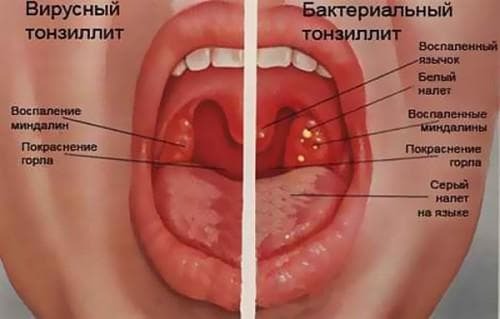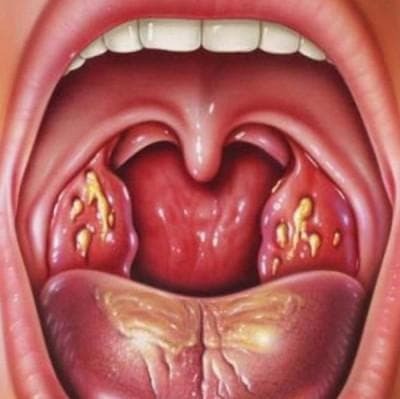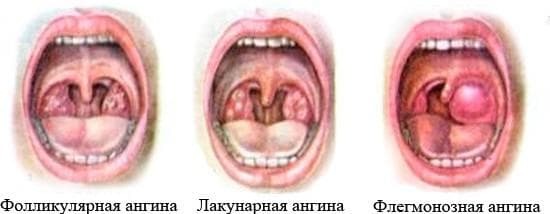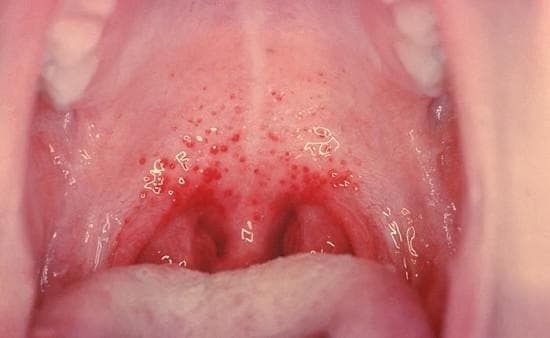
Young children often complain that they have a "sore neck."However, the sore throat is just a symptom that can speak of both a common cold and a more formidable disease - for example, angina. In the medical language it is called "acute tonsillitis".How can a mother in time recognize that a child is not just a banal viral inflammation in the throat, but a bacterial( that is, a sore throat) that requires mandatory prescription of antibiotics?
Contents of
Contents of
comes about What is different from the common cold
To begin with, let us explain that during a cold commonly called ARVI, a child's throat usually becomes inflamed due toreproduction in the body of viruses. They are usually not dangerous, and they themselves go without serious treatment - the main work here is provided by our immune system.
The photo shows how the sore throat looks like:

But the distinctive feature of angina is that it is caused by dangerous bacteria - usually a beta-hemolytic group A streptococcus.
This pathogen is very dangerous, since it can give numerous complications - on the heart,joints, lungs and kidneys. Researchers estimated that with it is associated with at least one third angina in children from birth to 18 years. It's extremely difficult to defeat him without antibiotics. Maybe, of course, without them, the illness will pass, but it is likely that acute tonsillitis will turn into a chronic, which in the future will be constantly aggravated. The link describes the symptoms of streptococcal angina.
The video tells how the sore throat looks like:
And one more distinctive feature of angina is that it affects mainly tonsils, which we usually used to call glands. It is a pair of formations, similar to beans, on both sides of the pharynx. With angina, they usually swell, which is due to inflammation of the lymph nodes. And if the child has evenly blushed all the throat( as a rule, we are talking about the back wall, the sky, palatine arch), then he has a common cold.
Occurrence of
Until three years, angina is rare in children. This is explained by the fact that the child's tonsils have not yet properly formed. But if the inflammation still occurs, the child is usually hospitalized in a hospital.
On the photo - looks like sore throat in adults:

And here in children three years old and older, sore throats happen quite often:
- drank cold, licked icicles and snow,
- just soaked feet
And now the temperature is 38-39, chills, headachepain and complete inability to jump and jump because of the general intoxication of the body. Of course, angina is carried by children much harder than banal ARVI - and this will be noticed by any mom. Cough and cold at angina does not happen.
The video tells about the occurrence of sore throat:
It is usually difficult for parents to force a child to open their mouths to carefully examine the sore throat. But if you still succeed, pay attention to the following symptoms. The child has a red throat, and first of all - the tonsils themselves. In this case the tonsils are enlarged and swollen. If the child has a moderate or severe disease, the mother or father will be able to treat purulent deposits on the tonsils - these may be small white islands or even extensive films. In this case, you need to seek medical help.
What forms are found in children
Angina in children can occur in a variety of forms, but the most common are three:
- catarrhal,
- follicular,
- lacunar.
They differ in the depth of the destruction of the tonsils. Parents are unlikely to be able to determine the form of angina in a child - it's the prerogative of a doctor, but you still need to know about them. 
- The is the easiest. The tonsils are red and swollen, but they do not have a characteristic white purulent coating. Sore throat, poor health and headache, of course, are present, but with this type of sore throat, there is not even any major change in blood tests. Here you can read about how to treat catarrhal angina at home. Also read about the causes of catarrhal angina.
- With follicular on inflamed and enlarged tonsils, you can see white-yellow points - purulent plugs( purulent).After a certain time, they will begin to open, and the severity of the disease will decline. But you can not cancel antibiotics anyway. The link describes the incubation period of follicular sore throat.
- With lacunar ( this name is derived from the word lacunae - it is a kind of "corridors" that go deep into the tonsils) glands blush and swell, they have a purulent coating, which can be accompanied by the appearance of bad breath. The islets of pus merge with each other.
If you have any purulent formations on the tonsils, you should consult a doctor, preferably an otolaryngologist. Different types of raids can speak not only of angina - it may be long forgotten by all of us diphtheria, fungal infection of the pharynx, infectious mononucleosis or scarlet fever.
Doctors call such an angina specific - that is, caused by specific pathogens.
Another type - herpetic( herpes) tonsillitis. Here you can read about the treatment of herpetic sore throat in children. The link describes how long does herpes sore throat in children. Photo:

When the recovery comes

Another important feature of angina is its infectiousness. It is true, streptococci and staphylococci are not transmitted through the air, but through common objects of use. Hardly suspecting the baby's sore throat, try to give him a separate dish, a towel, and also to isolate from other children.
A doctor can confirm or deny a sore throat, which the mother suspected of having a baby. He also will appoint the right treatment - an antibiotic, local antiseptics, will recommend the right diet and a bed rest. When using antibacterial therapy in a child's body, not only harmful but also beneficial microflora is usually killed, so it is usually necessary to take medications that normalize the intestinal flora. Otherwise, candidiasis may occur - a fungal infection of the body.
If the medicine is selected correctly, there will be no trace of angina after 5-7 days, and the child's condition will improve significantly 1-2 days after the beginning of taking the tablets. Correctly and in time treated tonsillitis does not give complications and does not become chronic.
In the photo - symptoms of angina in a child:

Sometimes angina in children occur so often that parents are offered to think about removing tonsils. Usually, this problem is a consequence of the once-ill acute tonsillitis. Refuse to remove the glands is not worth it, but to run headlong into the operation - too. Weigh the pros and cons, consult with several specialists and make the only correct decision. In any case, the role of tonsils in the human body is so high that they need to be treated with special attention. Here you can read about the pathogens of angina. Here, treatment and prevention of angina are described. Also, read than gargle with purulent sore throat. Here you can see if the sore is transmitted by airborne droplets.
